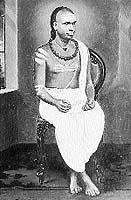Maha Vaidyanatha Iyer
Maha Vaidyanatha Sivan (Tamil: மஹா வைத்யநாத சிவன்) (23 May 1844 – 27 January 1893) was a composer of Carnatic music. He was a great exponent of extemporaneous singing. He also composed a ragamalika (garland of ragas - a song that utilises more than one raga) with all the 72 melakartha ragas.

Vaidyanatha Iyer was born in the village of Viyacheri in the Thanjavur districts of Tamil Nadu. His father Duraisami Iyer was also a musician and he trained Vaidyanatha Iyer as well as his other sons in Carnatic music. Vaidyanatha Iyer continued his training with some of the well known musicians of his time including Anai Ayya brothers. Later he continued his training under Manambuchavadi Venkatasubbayyar, one of Tyagaraja’s disciples. He was famous for his elaboration of ragas (raga alapana). Maha Vaidyanatha Sivan and his elder brother, Ramaswami Sivan, were the earliest performing duo in the history of Carnatic music as known in the last two centuries.
He composed mainly in Telugu and Tamil and used the mudra 'Guhadasa'. Some of his famous compositions are Pahimam Srirajarajeswari (Janaranjani) and Neekela dayaradu (Sarasangi).
Compositions
| Composition | Raga | Tala | Type | Language | Other Info | Audio Links |
|---|---|---|---|---|---|---|
| nIkEla daya rAdu | sarasAngi | khanDa cApu | Telugu | Credited to his brother Ramaswamy Sivan [1] | ||
| pAhimAm SrI rAja rAjEswarI | jana ranjani | Adi | Sanskrit | Credited to his brother Ramaswamy Sivan [2] |
Sudha Raghunathan - https://www.youtube.com/watch?v=f_QYi6J__iU | |
| praNatArti hara prabhO purArE | Raga Malika | Adi | Sanskrit | 72-Melakarta Raga malika |
R. Vedavalli - https://www.youtube.com/watch?v=Dtg_ntm6oSU | |
| Sri shankara guru varam | Naga Swarali | Rupaka | Sanskrit |
MS Sheela - https://www.youtube.com/watch?v=BTpD-ZS_41I |
See also
References
- Karnatica.com at the Wayback Machine (archived September 19, 2004)
- carnatica.net
- Carnaticcorner.com